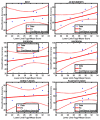Decoding of Ankle Joint Movements in Stroke Patients Using Surface Electromyography
- PMID: 33668229
- PMCID: PMC7956677
- DOI: 10.3390/s21051575
Decoding of Ankle Joint Movements in Stroke Patients Using Surface Electromyography
Abstract
Stroke is a cerebrovascular disease (CVD), which results in hemiplegia, paralysis, or death. Conventionally, a stroke patient requires prolonged sessions with physical therapists for the recovery of motor function. Various home-based rehabilitative devices are also available for upper limbs and require minimal or no assistance from a physiotherapist. However, there is no clinically proven device available for functional recovery of a lower limb. In this study, we explored the potential use of surface electromyography (sEMG) as a controlling mechanism for the development of a home-based lower limb rehabilitative device for stroke patients. In this experiment, three channels of sEMG were used to record data from 11 stroke patients while performing ankle joint movements. The movements were then decoded from the sEMG data and their correlation with the level of motor impairment was investigated. The impairment level was quantified using the Fugl-Meyer Assessment (FMA) scale. During the analysis, Hudgins time-domain features were extracted and classified using linear discriminant analysis (LDA) and artificial neural network (ANN). On average, 63.86% ± 4.3% and 67.1% ± 7.9% of the movements were accurately classified in an offline analysis by LDA and ANN, respectively. We found that in both classifiers, some motions outperformed others (p < 0.001 for LDA and p = 0.014 for ANN). The Spearman correlation (ρ) was calculated between the FMA scores and classification accuracies. The results indicate that there is a moderately positive correlation (ρ = 0.75 for LDA and ρ = 0.55 for ANN) between the two of them. The findings of this study suggest that a home-based EMG system can be developed to provide customized therapy for the improvement of functional lower limb motion in stroke patients.
Keywords: ankle joint movements; home-based physical therapy; lower limb functional recovery; pattern recognition (PR); stroke rehabilitation; surface electromyography (sEMG).
Conflict of interest statement
The authors declare no conflict of interest.
Figures








Similar articles
-
Decoding Attempted Hand Movements in Stroke Patients Using Surface Electromyography.Sensors (Basel). 2020 Nov 26;20(23):6763. doi: 10.3390/s20236763. Sensors (Basel). 2020. PMID: 33256073 Free PMC article.
-
Proportional estimation of finger movements from high-density surface electromyography.J Neuroeng Rehabil. 2016 Aug 4;13(1):73. doi: 10.1186/s12984-016-0172-3. J Neuroeng Rehabil. 2016. PMID: 27488270 Free PMC article.
-
Upper-limb functional assessment after stroke using mirror contraction: A pilot study.Artif Intell Med. 2020 Jun;106:101877. doi: 10.1016/j.artmed.2020.101877. Epub 2020 May 19. Artif Intell Med. 2020. PMID: 32593396
-
Robotic-assisted therapy with bilateral practice improves task and motor performance in the upper extremities of chronic stroke patients: A randomised controlled trial.Aust Occup Ther J. 2019 Oct;66(5):637-647. doi: 10.1111/1440-1630.12602. Epub 2019 Jul 17. Aust Occup Ther J. 2019. PMID: 31317553 Clinical Trial.
-
Metrology in sEMG and movement analysis: the need for training new figures in clinical rehabilitation.Front Rehabil Sci. 2024 Jan 29;5:1353374. doi: 10.3389/fresc.2024.1353374. eCollection 2024. Front Rehabil Sci. 2024. PMID: 38348456 Free PMC article. Review.
Cited by
-
Insights into motor impairment assessment using myographic signals with artificial intelligence: a scoping review.Biomed Eng Lett. 2025 Jun 5;15(4):693-716. doi: 10.1007/s13534-025-00483-7. eCollection 2025 Jul. Biomed Eng Lett. 2025. PMID: 40621607 Free PMC article. Review.
-
Identification and quantification of muscular cocontraction for ankle rehabilitation through variational mode decomposition in surface electromyography.Sci Rep. 2025 Apr 28;15(1):14847. doi: 10.1038/s41598-025-96334-7. Sci Rep. 2025. PMID: 40295627 Free PMC article.
-
On the Applications of EMG Sensors and Signals.Sensors (Basel). 2022 Oct 19;22(20):7966. doi: 10.3390/s22207966. Sensors (Basel). 2022. PMID: 36298317 Free PMC article.
References
-
- Vos T., Allen C., Arora M., Barber R.M., Brown A., Carter A., Casey D.C., Charlson F.J., Chen A.Z., Coggeshall M., et al. Global, regional, and national incidence, prevalence, and years lived with disability for 310 diseases and injuries, 1990–2015: A systematic analysis for the Global Burden of Disease Study 2015. Lancet. 2016;388:1545–1602. doi: 10.1016/S0140-6736(16)31678-6. - DOI - PMC - PubMed
-
- Lackland D.T., Roccella E.J., Deutsch A.F., Fornage M., George M.G., Howard G., Kissela B.M., Kittner S.J., Lichtman J.H., Lisabeth L.D., et al. Factors influencing the decline in stroke mortality a statement from the american heart association/american stroke association. Stroke. 2014;45:315–353. doi: 10.1161/01.str.0000437068.30550.cf. - DOI - PMC - PubMed
MeSH terms
LinkOut - more resources
Full Text Sources
Other Literature Sources
Medical
Research Materials

